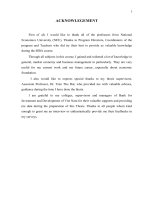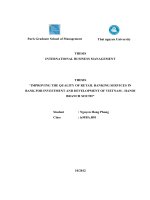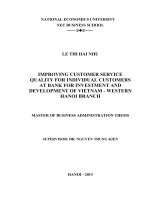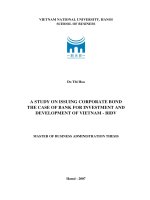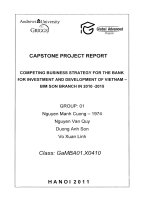Improving the quality of card services at bank for investment and development of vietnam sogiaodich 1 branch
Bạn đang xem bản rút gọn của tài liệu. Xem và tải ngay bản đầy đủ của tài liệu tại đây (1.27 MB, 93 trang )
ĐẠI HỌC QUỐC GIA HÀ NỘI
KHOA QUẢN TRỊ VÀ KINH DOANH
---------------------
CAO LAN ANH
IMPROVING THE QUALITY OF CARD SERVICES AT BANK
FOR INVESTMENT AND DEVELOPMENT OF
VIETNAM – SOGIAODICH 1 BRANCH
NÂNG CAO CHẤT LƢỢNG DỊCH VỤ THẺ TẠI NH TMCP ĐẦU TƢ
VÀ PHÁT TRIỂN VIỆT NAM – CHI NHÁNH SỞ GIAO DỊCH 1
LUẬN VĂN THẠC SĨ QUẢN TRỊ KINH DOANH
Hà Nội - 2017
ĐẠI HỌC QUỐC GIA HÀ NỘI
KHOA QUẢN TRỊ VÀ KINH DOANH
---------------------
CAO LAN ANH
IMPROVING THE QUALITY OF CARD SERVICES AT BANK
FOR INVESTMENT AND DEVELOPMENT OF
VIETNAM – SOGIAODICH 1 BRANCH
NÂNG CAO CHẤT LƢỢNG DỊCH VỤ THẺ TẠI NH TMCP ĐẦU TƢ
VÀ PHÁT TRIỂN VIỆT NAM – CHI NHÁNH SỞ GIAO DỊCH 1
Chuyên ngành: Quản trị kinh doanh
Mã số: 60 34 01 02
LUẬN VĂN THẠC SĨ QUẢN TRỊ KINH DOANH
NGƢỜI HƢỚNG DẪN KHOA HỌC: TS. PHẠM THỊ THANH HÒA
Hà Nội - 2017
LỜI CẢM ƠN
Tôi xin bày tỏ lòng biết ơn sâu sắc đến các thầy cô giáo Khoa Quản trị và Kinh
doanh, Trường Đ ại học Quốc Gia Hà Nội, đặc biệt là các thầy cô đã truyền đ ạt cho tôi
nhiều kiến thức và đ ã tạo điều kiện giúp tôi thực hiện bản luận văn này.
Tôi xin bày tỏ lòng biết ơn chân thành đến TS. Phạm Thị Thanh Hòa đã dành nhiều thời
gian tâm huyết, tận tình hướng dẫn, chỉ bảo cho tôi trong suốt quá trình thực hiện đề tài.
Tôi xin chân thành cảm ơn Ban lãnh đ ạo Ngân hàng Thương Mại Cổ Phần Đầu
Tư và Phát Triển Việt Nam chi nhánh Sở Giao Dịch 1 và các anh chị em ở các phòng
nghiệp vụ của chi nhánh và phòng giao dịch đã tạo điều kiện thuận lợi, giúp đỡ tôi
trong việc thu thập số liệu và những thông tin cần thiết cho việc nghiên cứu luận văn này.
Tôi xin chân thành cảm ơn gia đình, bạn bè và đồng nghiệp đã đ ộng viên khích lệ và
giúp đỡ tôi trong quá trình học tập và nghiên cứu.
ACKNOWLEDGEMENT
I would like to express my deep gratitude to the teachers of the Hanoi school of
Business and Management, Vietnam National University, especially the teachers who
imparted to me a lot of knowledge and helped me. Carry out this essay.
I would like to express sincere gratitude to TS. Pham Thi Thanh Hoa has spent a lot
of time, dedicated guidance, only told me during the course of the topic.
I would like to express my sincere thanks to the Board of Directors of Joint Stock
Commercial Bank for Investment and Development of Vietnam – Sogiaodich 1 Branch
and for the siblings in the professional sections of branches and transaction offices who
created favorable conditions. Help me in collecting data and information needed for the
study of this thesis.
I sincerely thank family, friends and colleagues for encouraging and supporting me
in the process of study and research.
Hanoi, date 25 month 5 year 2017
Student
CAO LAN ANH
TABLE OF CONTENTS
ABBREVIATION ................................................................................................................. i
LIST OF FIGURES ............................................................................................................. ii
LIST OF TABLES .............................................................................................................. iii
INTRODUCTION ............................................................................................................... 1
CHAPTER 1: OVERVIEW OF CARD SERVICES AND QUALITY OF CARD
SERVICES OF COMMERCIAL BANKS ........................................................................ 5
1.1 Overview of card services at commercial banks .................................................... 5
1.1.1 Definition and characteristics of card services of commercial banks .............. 5
1.1.2 The role and benefits of card services of commercial banks ............................ 6
1.1.3 Main activities of card services at commercial banks ...................................... 7
1.2 Quality of card services at commercial banks...................................................... 10
1.2.1 Definition of card service quality ................................................................... 10
1.2.2 The necessity of improving card operations of commercial banks ................. 10
1.2.3 Evaluation models of card service quality at commercial banks ................... 11
1.3. Experience in enhancing the quality of card services at some banks and lessons
drawn for BIDV - Sogiaodich 1 Branch...................................................................... 16
1.3.1. Experience of foreign banks .......................................................................... 16
1.3.2 Experience of domestic commercial banks ..................................................... 18
1.3.3. Experience lessons drawn for BIDV – Sogiaodich 1 Branch ........................ 19
CHAPTER 2: REALITY OF CARD SERVICE QUALITY AT BIDV – .................... 21
SOGIAODICH 1 BRANCH ............................................................................................. 21
2.1 Introduction of BIDV – Sogiaodich 1 Branch ...................................................... 21
2.1.1 Foundation and development history ............................................................. 21
2.1.2 Operating model of BIDV – Sogiaodich 1 Branch ......................................... 22
2.1.3 Business results ............................................................................................... 22
2.2 Reality of the card service quality at BIDV – Sogiaodich 1 Branch in recent
years ............................................................................................................................... 24
2.2.1 Results of card business .................................................................................. 24
2.2.2 Reality of card service quality at the branch in recent years ......................... 31
2.2.3 Reality of card service quality at BIDV – Sogiaodich 1 Branch .................... 36
2.3 Evaluation of the quality of card services at BIDV – Sogiaodich 1 Branch ...... 50
2.3.1 Achievements .................................................................................................. 50
2.3.2 Limitations and causes ................................................................................... 51
CHAPTER 3: SOLUTIONS TO IMPROVE THE QUALITY OF CARD SERVICES
AT BIDV – SOGIAODICH 1 BRANCH ......................................................................... 54
3.1 Developing orientations of card operations at the bank ..................................... 54
3.2 Solutions to improve the quality of card services at BIDV Bank – Sogiaodich 1
Branch ............................................................................................................................ 55
3.2.1 Investing solutions to improve facilities and demand meeting ability ............ 55
3.2.2 Solutions to improve service deployment outcome ......................................... 57
3.2.3 Solutions to complete the service providing process ...................................... 59
3.2.4 Solutions to complete the management operation .......................................... 60
3.2.5 Solutions to strengthen the brand image of the branch .................................. 62
3.2.6 Solutions to enhance responsibility with society and community ................... 63
3.3 Reccomendations .................................................................................................... 63
3.3.1 Reccomendations to the State Bank ................................................................ 63
3.3.2 Recommendations to BIDV Head Office ........................................................ 64
3.4.3 Recommendations to the association of card issuing and payment banks ..... 66
CONCLUSIONS, LIMITATIONS, AND CONTRIBUTIONS OF THE STUDY ...... 67
REFERENCES .................................................................................................................. 69
APPENDIX
ABBREVIATION
Abbreviation
Meaning of acronym
ACB
Asia Commercial Bank
ATM
Automatic Teller Machine
BIDV
Joint Stock Commercial Bank for Investment and Development of
Vietnam
CVV
Card Verification Value
EDC
Electronic Data Capture
PIN
Personal Identification Number
POS
Point of Sale
i
LIST OF FIGURES
Figure 1.1: Research model of Parasuraman et al. (1988)................................................... 11
Figure 1.2: Research model of Thai Van Vinh và Devinder Grewal (2007)....................... 12
Figure 1.3: Research model of Huynh Thuy Phuong (2010) .............................................. 13
Figure 1.4: Research model of Nguyen Thi Kieu Linh (2009) ........................................... 14
Figure 1.5: Research model of Lê Thị Thu Hương (2014).................................................. 15
Figure 1.6: Proposed research model .................................................................................. 16
ii
LIST OF TABLES
Table 2.1: Business results of the branch in the stage of 2013 -2015 ................................. 22
Table 2.2: Results of card service business ......................................................................... 24
Table 2.3: Number of ATM cards at the branch.................................................................. 26
Table 2.4: Revenue from card services ............................................................................... 28
Table 2.5: Number of international payment cards at the branch ....................................... 29
Table 2.6: Revenue from international payment card services ........................................... 30
Table 2.7: Some training activities of card staff at the branch ............................................ 32
Table 2.8: Some advetising and marketing activities for card products .............................. 33
Table 2.9: Distribution system and management technology of card service business ...... 34
Table 2.10: Common risks in card service business at the branch ...................................... 35
Table 2.11 Results of the scale reliability testing ................................................................ 37
Table 2.12 Results of independent factor analysis .............................................................. 39
Table 2.13 Rotated component matrix of independent variables ........................................ 40
Table 2.14 Results of dependent factor analysis ................................................................. 41
Table 2.15 Rotated component matrix of dependent variables ........................................... 42
Table 2.16 Multiple regression analysis .............................................................................. 42
Table 2.17 Regression coefficients ...................................................................................... 43
Table 2.18 Evaluation of resources ..................................................................................... 44
Table 2.19 Evaluation of outcome....................................................................................... 45
Table 2.20 Evaluation of process ........................................................................................ 46
Table 2.21 Evaluation of management ................................................................................ 47
Table 2.22 Evaluation of image ........................................................................................... 48
Table 2.23 Evaluation of social responsibility .................................................................... 49
Table 2.24 Evaluation of the quality of card services ......................................................... 50
iii
INTRODUCTION
1. Rationale of the study
Nowadays, the increasing development of science and technology contributes
considerably to the improvement of people’s life quality. People are more and more
accessible to safer and more sophisticated service products. Banking service products are
one of the breakthroughs on the basis of modern science and technology. One of those
service products is bank cards. Customers using cards can conveniently carry out many
transactions such as payment, transfer, cash withdrawal, internet payment, etc. without
having to go to the bank. As a result, card products are becoming friendlier, closer, and
being widely accepted by consumers. As for the banks, card products also bring them a lot
of intangible benefits such as raising the banks’ position, promoting their brand image, and
attracting customers to the banks. These are also business activities bringing revenue to the
banks. These are the annual fees that cardholders must pay under the card use contract;
cash withdrawal fee (4% for issuing bank and at least 50,000 VND for one transaction);
fees for payment transaction of goods and services by credit card at card accepting units
(2.5% of the value of each transaction, commercial discount (for agent banks that help
conduct payment transaction for issuing banks); some other fees such as credit card penalty
fee, checking fee (fee that cardholders pay for their checking requirements), fee for card reissuance (due to theft or loss) and card exchange (as requested by cardholders), fee for
posting stolen or lost cards to the list of forbidden circulation.
With the advantages that card services bring, each bank has built its own strategies to
dominate the market and develop its card service brand. The competition in developing
card services of commercial banks nowadays has made customers’ demands more and
more satisfied and made the card service market become more active than ever. Therefore,
the improvement of card service quality is very important and necessary for commercial
banks.
In the past few years, BIDV – Sogiaodich 1 Branch has implemented a lot of measures
to improve the quality of card services. However, the card services of BIDV still have
several shortcomings. For example, many customers apply for a card issuance but do not
get the cards, causing the cost wastage for the bank. The problem of overdue credit card
debt is arising. Besides, the habit of using cash has existed in Vietnamese people’s minds
for a long time. Therefore, the aim of Sogiaodich 1 Branch is to improve the quality of
card services in order to expand the card product market and better control risks in card
business. For this reason, the author selected the topic "Improving the quality of card
1
services at Bank for Investment and Development of Vietnam – Sogiaodich 1 Branch " as
my MA thesis.
2. Overview of the study
The quality of card services is one of the factors affecting card service business, which
brings a lot of revenue to current commercial banks. Thus, there are lots of studies related
to the operation as well as the quality of card services. Some related studies are presented
as follows.
Le Thi Thu Ha (2015) conducted a study on the management of card business at Joint
Stock Commercial Bank for Foreign Trade of Vietnam (Vietcombank), Hai Duong branch.
The study focused on the contents related to card business management including
management planning, implementation of management plans, and inspection and
supervision of the management plan implementation. Moreover, the study also focused on
clarifying risks in card business and causes of the risks in card business at Vietcombank –
Hai Duong branch. Nevertheless, the study did not present the issues related to the quality
of card services, which is a prerequisite for achieving the goal of expanding and
developing card services in a potential market like Hai Duong.
The study of Dinh Nguyen Hoai Phuong (2011) aimed at exploring the solutions for
card service development at Asia Commercial Bank (ACB). The research focused on
analyzing the reality of card service development and measuring the satisfaction of
employees and customers on the card product development at Asia Commercial Bank.
Despite the fact that the expansion and development of card services are always
accompanied by potential risks, the author did not focus on presenting the risks of the bank
in card business to have a right developing orientation and a risk forecasting ability.
Therefore, the solutions that the author proposed were still general and quite unreasonable
in the card business environment with a lot of potential risks.
Bui Thi Thanh Huong (2013) carried out a study on card product development at
Vietnam Bank for Agriculture and Rural Development (Agribank). In her study, the author
concentrated on analyzing the reality of card service developing solutions that were applied
by Agribank such as marketing solutions, technology solutions, affiliating solutions, card
risk management solutions, human solutions, and cost solutions. However, the analysis of
the solution groups was only based on the collection and analysis of secondary data from
the card business of Agribank in the author’s point of view. The collection of customer
opinions through surveys wasn’t conducted, which decreased the objectivity of the thesis.
2
Hossain Shahriar (2008) conducted a study on customer satisfaction with credit cards at
Prime Commercial Bank of Bangladesh. The purpose of the study was to have an overview
of the users’ satisfaction with credit cards of Prime Commercial Bank in Bangladesh. To
carry out the reaseach, the author conducted a survey measuring the influence of factors on
customer satisfaction with credit cards of Prime Commercial Bank of Bangladesh.
However, credit cards were just one type of bank cards. In Vietnam, credit cards are still
quite new and not widely accepted by many customers. Other card products such as
payment cards and domestic debit cards are still dominating in the card business of
Vietnamese commercial banks nowadays. Therefore, the solutions proposed by the author
were difficult to apply in the card business of commercial banks in Vietnam.
The reseach of Han Kuo Tan (2009) explored different aspects of service quality and
customer expectations from credit card issuers in Malaysia. The research showed that the
card issuers wishing to improve their competitiveness in the market needed to offer multifunctional credit cards, contributing to enhancing customer satisfaction. The research
proposed some recommendations for card issuers to improve the quality of their credit card
services. However, the author failed to mention the risks in credit card business. It is a fact
that if banks are only interested in developing their credit cards without paying attention to
the risk control and management in the card business, serious losses which reduce the
banks’ business operations can be caused.
To sum up, there have been many studies related to the business operations as well as
the quality of card services. However, there have been no studies dealing comprehensively
with the quality of card services and the risks in card business in order to propose the
solutions to improve the quality of card products at BIDV – Sogiaodich 1 Branch.
Therefore, the research topic of the author is not duplicated with previous research topics.
3. Objectives of the study
3.1 Overall objective
- Studying the quality of card services at BIDV – Sogiaodich 1 Branch in order to
propose the solutions to improve the quality of card services at this bank.
3.2 Specific objectives
- Building a theoretical basis on card services and quality of card services.
- Studying the development reality of card services and the quality of card services at
BIDV – Sogiaodich 1 Branch, from which the author will assess the quality of card
services at BIDV – Sogiaodich 1 Branch.
3
- Propose some solutions to improve the quality of card services at BIDV – Sogiaodich
1 Branch .
4. Subject of the study
The study focuses on quality of card services at BIDV – Sogiaodich 1 Branch.
5. Scope of the study
- In terms of space: The study was conducted in BIDV – Sogiaodich 1 Branch
- In terms of time:
+ Secondary data: Secondary data were collected in the stage of 2013 – 2015 at BIDV –
Sogiaodich 1 Branch.
+ Primary data: Primary data were collected from survey questionnaires to the
customers from August to September, 2016.
6. Methodology
In this thesis, the author combined comparative and synthetic analysis methods.
+ Comparative method was used to compare the changes of indicators reflecting the
results of card business, the development of card products over the years (number of
customers, number of cards, and costs in card business).
+ Synthetic analysis method was used to analyze the development reality of card
products and the risks in card business (pointing out the causes of changes and explaining
the reasons for changes in the development of card products, and the risks in card
business).
+ Investigation Method: The author uses the survey method to assess the satisfaction of
customers using the card products through questionnaires. Survey results were processed
using SPSS software
7. Organization of the thesis
This thesis was divided into three chapters:
Chapter 1: Overview of card services and quality of card services at commercial banks.
Chapter 2: Reality of card service quality at BIDV – Sogiaodich 1 Branch.
Chapter 3: Solutions to improve card quality at BIDV – Sogiaodich 1 Branch.
4
CHAPTER 1: OVERVIEW OF CARD SERVICES AND QUALITY OF CARD
SERVICES OF COMMERCIAL BANKS
1.1 Overview of card services at commercial banks
1.1.1 Definition and characteristics of card services of commercial banks
* Definition
A bank card is a payment tool issued by a card issuing bank to a customer to conduct
payment for goods or services or withdraw cash within the scope of his or her deposit
balance or allowed credit limit. Card services are used to perform services through
automatic trading systems, also known as ATM service systems. In other words, a bank
card is a means issued by a card issuer to carry out card transactions in accordance with the
terms and conditions agreed by the parties (Governor of the State Bank of Vietnam, 2007).
Bank card services are non-cash payment services originated from the method of purchase
and sale of retail goods on credit and have developed associated with the application of
information technology in the field of finance and banking (Mwatsika, 2014).
* Characteristics of card services
A card is a payment tool with different characteristics from other payment tools.
Nowadays, when information technology develops at a high level, card payment service is
a popular payment method replacing other traditional payment methods. This is because
card services have a lot of outstanding features compared to other means of payment.
- Flexibility: With a variety of cards suitable for all people from high-income customers
(gold cards) to low-income customers (standard cards), cards can be used to withdraw cash
or pay for goods and services, etc. A card is regarded as a modern, safe, and fast
“electronic wallet” helping cardholders control their spending activities.
- Convenience: A card is a means of non-cash payment bringing customers many
benefits that no other means of payment can compare. Cardholders can use their card to
pay for goods and services in anywhere at anytime without having to carry cash or travel
checks. For credit cards, customers can also be provided with a credit limit by the bank.
Customers can make advance payments and repay money later without interest within a
period of time. In addition, cardholders also enjoy many preferential treatments from the
bank such as free information on banking services, accounts, exchange rates, 24/24
services, etc. Cardholders can also get preferential discounts when making payment at card
accepting units or enjoy competitive interests on the account balance.
5
- Security and rapidity: Cards are made based on very modern and sophisticated
technology and are difficult to counterfeit, so the security of the card is very high.
Especially when smart cards are launched to the market, their security is increased;
therefore, they are widely used in the market. When cards are lost or PINs are revealed,
cardholders can notify the bank to lock the card account in time to avoid the thieves' ability
to withdraw the money.
Cards are often small and light, so it is easier for cardholders to carry when they have to
make a large amount of payment or moving far. When shopping for goods or services,
customers only need to show their cards and sign payment slips to complete the payment.
This means customers have saved the costs of transporting and counting.
1.1.2 The role and benefits of card services of commercial banks
When the economy is developed, the improvement in people's living standards and
incomes leads to the development of many types of services, in which financial services,
especially card services, are increasingly developing. These services bring many benefits
to customers who are using cards. The banking system links the activities in the economy
through card services; therefore card services play a vital role in economic transactions.
+ For card users:
Customers using cards are mainly individuals since these services are introduced to
primarily serve individuals in the transaction process. As people's incomes are increasing,
the transaction demands are also going up with the development trend. The storage of cash
in transactions is very large, so the demands for transactions via card services are
increasing to reduce the risks in cash transactions. Moreover, customers can access faster
to their accounts, which are more convenient, secure, and efficient with better time
management and less time of traveling. Along with that trend, banks are constantly
improving the quality as well as mordernizing their services to serve customers better.
+ Card services help develop banking industry
Nowadays, there are a lot of banks in the financial market. The evaluation of the bank
reputation through the quality of card services is very important because customers are
people who decide which banks they want to use based on the quality of their card services
and the security that these services offer. Customers often perceive that if the service
quality of a bank is the best, that bank is reliable. Thus, banks need to focus on improving
the service quality including the quality of card services.
Regarding enterprises outside the banking industry, the impact from the development of
card services is very big. Apart from companies using ATM cards to pay salaries to their
6
staff, many other service enterprises such as commercial centers or mobile operators also
have services associated with the development of card services. People using postal and
telecommunications services can conveniently make their cost payment by card. In
addition, people can also easily pay by card when they go shopping at supermarkets.
+ Card services contribute to the development of the economy
Card services can not affect the entire economy. However, the quality improvement of
these services will make the economy more civilized.
- Reducing social costs: The use of card transactions helps reduce a big amount of cash
in circulation, thereby reducing the costs of printing, issuing, transporting cash, destroying
old money, as well as reducing counterfeit money.
- Speeding up payment activities:
Card services improve people’s belief in the operation of the banking system thanks to
the security, high accuracy, and time saving. At the same time, the government can control
the transactions of individuals, enterprises, and the whole economy as a basis for
calculating the monetary supply as well as operating more effective monetary policies.
The application of modern technology in card issuance and payment creates conditions
for the national economy to integrate and gradually catch up with the world economy.
- Minimizing some of the illegal economic activities, contributing to the management of
personal incomes, income taxes, and enhancing the decisive role of the govenment in the
economy.
1.1.3 Main activities of card services at commercial banks
* Issuing activities:
The issuing activities of banks include the management and implementation of the
entire card issuing process, card use, and debt collection. These three processes are all
important and should not be disregarded. Each process is closely related to the customer
service and the risk management for the bank. Financial institutions and banks issuing
cards must develop regulations on the use of cards and debt collection: minimum payment
amount, statement date, due date, fees and interests, maximum and minimum credit limits,
preferential policies, and so on.
Basically, card issuing activities are carried out as follows:
- Conducting marketing activities to bring products into the market
- Verifying card applicants
- Offering credit limits, especially for credit cards
- Designing and buying white cards
7
- Embossing and encoding
- Providing personal identification numbers (PINs) to cardholders
- Managing customer information
- Managing customers’ card use
- Managing debt collection from customers
- Providing customer service
- Clearing payments with international card organizations.
When carrying out issuing activities, apart from getting card issuance fees from
cardholders, banks also get the exchange fees that card payment banks collected from card
payment through international card organizations. This is the basic profit of financial
institutions and banks issuing cards. On the basis of this source of revenue, financial
institutions and banks issuing cards will offer customers other benefits and preferential
treatments to increase the mumber of card users and increase card use revenue.
* Payment activities:
The implementation of card payment activities of a bank is not only getting profits from the
discount fees calculated on the value of payment transactions by card from card accepting units
but also the desire to provide customers a complete service and a convenient basis for card use.
For international card organizations and their members, it is very important to encourage card
payment activities through expanding the network of card acceptors.
First, the payment activity of a certain type of card is expanded in a market meaning that
cardholders can use their cards more easily and conveniently. As people’s demands for tourism
and entertainment are increasing, the development of card payment market abroad becomes
more urgent. Card issuers and issuing banks pay maximum attention to how cardholders make
use of this non-cash payment method. The large number of card acceptors available throughout
potential markets and business lines means that bank cards are more widely accepted and bring
benefits to cardholders, card accpetors, and issuing banks.
Second, not just stopping at expanding the payment market by signing contracts with
new card acceptors, a card payment bank is particularly interested in maintaining
relationships with current card acceptors. This is reflected in the customer service of the
payment banks. Without proper policies and good support services enabling card card
acceptors to accept the customer's cards easily and being credited by the bank after
subtracting discount fee rates, other banks will take advantage of this situation to offer
more perfect services to these card acceptors. As a result, customers in payment activities
will decrease and the profit targets of the banks will deeply be affected.
8
In general, card payment activities are not just limited to the crediting to the card
acceptors under commitment. Instead, since the profits from card payment activities are not
small compared to the average business profits, the severe competition makes payment
banks always have appropriate marketing strategies and customer services. At the same
time, they have to provide card acceptors (who accept their customers’ cards) with free
services to enhance their competitiveness.
Card payment activities of banks are mainly conducted as follows:
- Building and managing the information system of customers and card acceptors
- Managing the operation of card acceptor network
- Conducting payment for card transactions to card acceptors
- Providing customer services
- Offering training on card payment methods to staff of card acceptors
- Supplying equipment and facilities for card payment
* Risk management activities:
The issuance and payment of bank cards face different types of risks such as illegal use
of cards by organizations or individuals, card acceptors not complying with instructed
procedures, counterfeit transactions, information being revealed to the third party, or card
acceptors not announcing business termination while still owing money to the bank. All
these behaviors cause risks and financial losses to the banks. Therefore, one of the key
areas of bank card business is the risk management.
The risk management department at issuing banks is considered the backbone of card
activities, which has the functions of:
- Preventing and investigating the use of counterfeit cards.
- Managing the list of accounts related to lost cards.
- Making plans to keep track of the security of card workpieces, printed cards, damaged
ards, and withdrawn cards.
- Updating information on the list of stolen or lost cards.
- Cooperating with relevant authorities in investigating and dealing with contract
breaches or counterfeit card use.
- Tracking and managing the operations of card center including operations of the staff.
- Organizing training sessions for card acceptors’ staff and cardholders on counterfeit
preventive measures.
The more the bank card business grows, the more the risk management sector is
invested. Experts in this field should be really knowledgeable about cards and modern
9
technology. Due to the ability to earn super profits, international criminal organizations are
by all means making use of modern technology to collect card data and customer accounts
to implement counterfeiting activities, which causes financial losses as well as bad
reputation to the banks and cardholders.
1.2 Quality of card services at commercial banks
1.2.1 Definition of card service quality
Before discussing the definition of card service quality, the author provides a brief
ofverview of service quality.
* Service quality:
Over a long time, researchers have tried to define and measure the perception of service
quality.
- According to Svensson (2002), service quality is reflected in the interaction process
between customers and employees of service providers. Lehtinen (1982) thinks that service
quality must be evaluated based on the two aspects, which are the service providing
process and the outcomes of the service. Gronroos (1984) also proposes two areas of
service quality which are technical quality and functional quality.
- Parasuraman et al. (1985), the pioneers in service quality research in marketing, offer a
five-gap model and components of service quality, which are abbriviated to SERVQUAL.
* Quality of card services
The quality of card services is the ability to meet the card service with the expectation
of customers using cards. In other words, it is all the additional benefit activities that the
banks give customers who are using cards with the aim to establish, consolidate, and
extend long-term partnerships with customers through the creation of customer satisfaction
(Le Hoang Duy, 2009).
1.2.2 The necessity of improving card operations of commercial banks
Card services are becoming more and more important in the economy. The
improvement of this activity is really essential for banks. The improvement in card
payment activities brings benefits not only to banks and customers but also to the
economy, contributing to the economic development. Moreover, the development and
improvement of card operations also aim at modernizing the banking sector, helping
Vietnam integrate into the world’s economic development trend. Regarding banks, through
card services, banks can attract huge deposits from customers with low deposit rates.
10
Card services are considered a strategic self-service banking channel and an important
tool for the activities of banks. Card services provide 24 hours a day and 365 days a year
banking operations and transactions and are located in strategic locations.
1.2.3 Evaluation models of card service quality at commercial banks
1.2.3.1 Service quality model of Parasuraman et al.
Parasuraman et al. (1988) initiated and conducted a quantitative and qualitative research
to develop and test the scale of service quality components (called SERVQUAL scale).
The SERVQUAL scale was adjusted and tested for a variety of services. Finally, the
SERVQUAL scale consisted of 22 variables which measured five components of service
quality including reliability, responsiveness, assurance, tangibles, and empathy. Namely,
according to the SERVQUAL model, service quality was defined as follows:
Service quality = Perceptions – Expectations
The research model of Parasuraman et al. (1988) was demonstrated as follows
Responsiveness
Tangibles
Service
quality
Empathy
Reliability
Assurance
Figure 1.1: Research model of Parasuraman et al. (1988)
Parasuraman et al. asserted that SERVQUAL was a complete scale for service quality,
which had a high value and reliability and could be applied to any types of service.
However, each service sector had its own characteristics. Many researchers had also tested
this scale with a wide range of services as well as in different countries. The results
showed that the components of service quality were not consistent across service sectors
and in different markets.
11
Therefore, due to the specificity of each type of service, researchers should adjust the
SERVQUAL scale so that it is suitable for each specific study.
1.2.3.2 ROPMIS service quality model of Thai Van Vinh and Devinder Grewal
The authors developed a model of card service quality consisting of 6 components: (1)
Resources (physical resources and financial capability of the bank), (2) Outcomes (what
customers enjoy when using card services), (3) Process (process of serving and satisfying
customers’ needs when they use card services), (4) Management (management capability
of the banks for card service business, (5) Image (image of the banks in customers’ eyes),
(6) Social responsibility.
After identifying the variables in the draft model, the authors conducted testing with
quantitative method in which data were collected through direct interviews with 1,250
clients and indirect interviews 1,000 customers online. Collected data were synthesized
and coded using Exel, and statistically verified using SPSS 20.0. The scales were checked
for reliability and Exploratory Factor Analysis (EFA). From the testing results, the authors
concluded that the initial research hypotheses were completely suitable. Therefore, the
research model of the author was presented as follows:
Six affecting components:
(1) Resources
(2) Outcomes
Card quality
service
(3) Process
(4) Management
(5) Image
(6) Social responsibility
Figure 1.2: Research model of Thai Van Vinh và Devinder Grewal (2007)
1.2.3.3 Card service quality model of Huynh Thuy Phuong
The author built a model to study the quality of Connect24 cards based on SERVQUAL
scale of Parasuraman et al. (1988). However, since each type of service has its own
characteristics, the author conducted qualitative research to adjust and add some
components suitable with card service quality at Vietnamese commercial banks.
Qualitative research was carried out via direct interviews with about 15 random clients
12
using ATM cards at Vietcombank and consultation with card department managers. The
results showed that the quality of card services included the following components (1)
reliability, (2) customer care skills, (3) security, (4) empathy, (5) tangibles, and (6)
accessibility with 31 variables to measure these components. That way, the author
developed her research model as follows:
Skills
Reliability
Security
Card service
quality
Empathy
Accessibility
Tangibles
Figure 1.3: Research model of Huynh Thuy Phuong (2010)
1.2.3.4 Card service quality model of Nguyen Thi Kieu Linh
According to Parasuraman, there were three main factors affecting customers’
expectations including personal needs, words of mouth, and experience in using the
service. However, in the process of building her research model, Nguyen Thi Kieu Linh
did not analyze the impact of these factors but focusing on collecting customers’ feedback
on expected services and their perceptions of the actual services. The author aimed to find
out what customers expected from card service quality when their demands arose.
Together with the exploration of customer expectations was the measurement of their
assessment on the actual services. The measurement of service quality was based on the
comparision of the difference between expectations and perceptions. This was also the
measure of distance in the theoretical model of Parasuraman.
13
In addition, in order to concretize customer expectations from card services, the author
used five components including tangibles, reliability, responsiveness, assurance, and
empathy. The SERQUAL scale of Parasuraman consisted of 22 verified variables that were
tested to be appropriate and comprehensive. However, the author had some adjustments
compared to the original model. The author’s research model was presented as follows:
Five components of
service quality
Expectations
- Tangibles
Card service
quality
- Reliability
- Responsiveness
Perceptions
- Assurance
- Empathy
Figure 1.4: Research model of Nguyen Thi Kieu Linh (2009)
1.2.3.5 Card sevice quality model of Le Thi Thu Huong
The author developed her research model based on a review of relevant literature in the
field of bank card services such as studies by Rahaman et al. (2011), Hasan (2013),
Mwatsika (2014), Kumbhar (2011), Ha Nam Khanh Giao (2011), and Le Thanh Dich
(2009). According to Le Thanh Dung (2009), the quality of card services was formed on
the basis of five components: employee skills, transaction security, reliability, tangibles,
and accessibility. Phung Tien Dat (2010) pointed out that there were five components
affecting the quality of card services including reliability, responsiveness, empathy, and
tangibles. In addition, the study of Mwatsika (2014) on customer satisfaction with the
quality of ATM services in Malawi pointed out that there were 5 components affecting
customer satisfaction with ATM services including reliability, responsiveness, empathy,
assurance, and tangibles. Besides, Hasan (2013) also concluded that customers would be
satisfied with the quality of ATM services offered by banks through such components as
reliability, responsiveness, convenience, and ease of use.
From the reviewed studies, Le Thi Thu Huong proposed a research model using
SERVPERF model and adjusted the measurement variables to suit the context of the study.
Accordingly, the research model of Le Thi Thu Huong was as follows:
14
Responsiveness
Reliability
Card service quality
Assurance
Empathy
Tangibles
Figure 1.5: Research model of Lê Thị Thu Hƣơng (2014)
1.2.3.6 Research model proposed by the author
After reviewing the research models to measure the service quality and card service
quality in previous studies, the author decided to adapt the ROPMIS model by Thai Van
Vinh and Devinder Grewal (2007) to study the quality of card services at BIDV –
Sogiaodich 1 Branch for the following reasons:
Firstly, the model was developed from the synthesis of many theories in different
studies (Dang Thanh Hung, 2012).
Secondly, the original ROPMIS model was implemented in the specific context of
Vietnam whereas other models are mainly tested in other countries. This meant that
applying ROPMIS model was appropriate because it was very close to the research scope
of the topic (Tran Trieu Khai, 2010).
Thirdly, although this model had not widely been used, some studies using ROPMIS
model to study card service quality showed positive results and demonstrated the
applicability of this model (Dang Thanh Hung, 2012).
Fourthly, the ROPMIS model used six components whereas other models were mainly
based on the SERQUAL model and the SERVPERF model which only consisted of five
components.
Thus, the proposed model for this study was stated as follows:
15
Resources
Outcomes
Process
Card service quality
Management
Image
Social responsibility
Figure 1.6: Proposed research model
The components in the model could be explained as follows:
- Resources: ability to meet the facilities and equipment for transactions related to card
services of banks.
- Outcome: ability to meet transaction time, level of performance of the bank's
commitments, accuracy, as well as security of transactions.
- Process: relates to attitude and behaviour of the banks’ staff when dealing with
customers’ requirements in their card-using process.
- Management: ability to manage card service business of the banks including the
application of information technology in card services, knowledge and skills of managers,
knowledge of the bank about card users, ways of dealing with customers’ complaints, etc.
- Image: refers to the relationship between banks with other commercial banks and
economic organizations to deal with transactions related to customers’ card services. It was
the perception of customers about the banks.
- Social responsibility: refers to the reliability and brand of the banks, the banks’
responsibilities to special subjects, customers, employees, and the community.
1.3. Experience in enhancing the quality of card services at some banks and lessons
drawn for BIDV - Sogiaodich 1 Branch
1.3.1. Experience of foreign banks
Experience of Citibank – The USA
16
